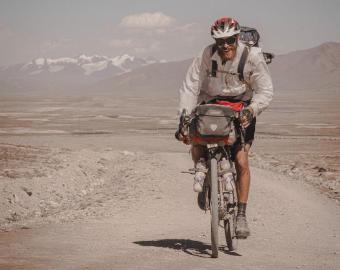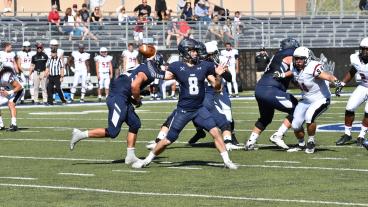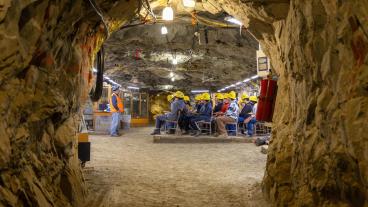

By Sarah Kuta, Special to Mines Magazine
Peter Consalvi ’17 has always wanted to live an unconventional life.
That desire has taken him on adventures across the globe, from serving on U.S. Navy warships to cycling thousands of miles across multiple continents.
“I don’t want to do the same things that everybody else does,” he said. “I wanted to branch out and learn about myself, learn about the world and just see what’s out there.”
It all started after high school, when Consalvi left his home in Maryland and moved across the country to study physics at Mines. As a student, Consalvi got his first bike—which he named “Oredigger”—and developed a passion for long-distance cycling. He also discovered his love of travel, visiting far-flung destinations like Costa Rica, Cuba, Nepal, Iceland and Greenland during summers and school breaks. “I was super fortunate to have amazing friends who were interested in exploring and going places and trying new things and spending time outdoors,” he said.
As a Mines sophomore, Consalvi enlisted in the U.S. Navy’s Nuclear Propulsion Officer Candidate (NUPOC) Program. The Navy paid him while he was in school, and in return, he agreed to spend at least five years working on ships and submarines after graduation.
While on active duty, Consalvi worked as a nuclear surface warfare officer in Spain, Japan and South Carolina, supervising the sailors who operate the nuclear reactors on naval vessels. He also got into ultrarunning, testing his mettle by completing three separate 100-mile runs.
When he got out of the Navy, Consalvi wanted to keep exploring the world. With savings he’d accrued while he was in the military, Consalvi decided to embark on an 18-month, self-supported bike journey. “I wanted to take a big chunk of time off after getting out, and I wanted to do something different,” he explained.
In the end, he pedaled 15,000 miles across four continents, riding from Mongolia to Spain—with a brief jaunt through Egypt—followed by Miami to Maryland. He carried everything he needed with him, from a tent and sleeping bag to food, water and cooking gear, a style of travel known as “bikepacking.” Consalvi, who was sponsored by the outdoor gear company Big Agnes for the trip, also raised more than $7,000 for Juniper Fund, an organization supporting the families of Sherpas who die while working in the Himalayas.
Though he was alone on his bike most of the time, the endeavor also opened his eyes to the power of human connection. “I met so many people on the road,” he said. “You might not speak the same language as someone, you might come from a completely different walk of life, but you can still relate. I spent a night with camel herders in Saudi Arabia, and in the morning when I left, these guys had tears in their eyes. And I felt it, too. We had shared this really special experience.”
Near the end of his bicycle trek, Consalvi heard about a group of military veterans who were attempting to run across the country while carrying an American flag, an initiative called the Old Glory Ultra Relay. It seemed like the perfect challenge to try next.
Consalvi was selected to join the 12-person team but was later sidelined by an injury. So, instead of running, he became the team’s crew chief.
“It sounds like a simple thing, but it was actually quite complex because the flag never stopped moving,” he explained. “It was 24/7, all through the night, coordinating the locations where the teams would meet and exchange the flag, where people were sleeping at night, where we were going to get food and water.”
The group successfully completed the 3,000-mile, coast-to-coast relay in 16 days in May 2025. They also raised more than $1 million for Team Red, White & Blue, a nonprofit dedicated to helping veterans lead healthier lives. For Consalvi, those fundraising results were just as important—if not more so—as the team finishing the relay. “Something both trips really reaffirmed about myself is that I want to give back—I want to live a life of service,” he said.
Looking ahead, Consalvi isn’t quite sure what the future holds. For now, he’s focused on recovering from major hip surgery and writing his first book, a biography of a Sherpa who summited Mount Everest 16 times. He’s also using this time to reflect on his journey so far—an unorthodox path he hopes might serve as a source of inspiration to others.




